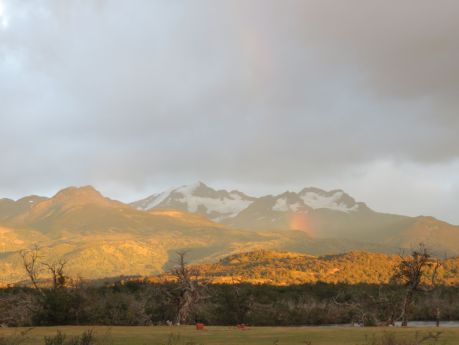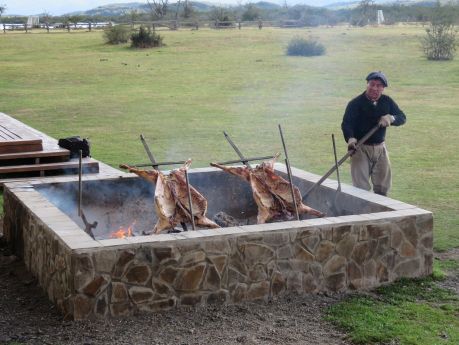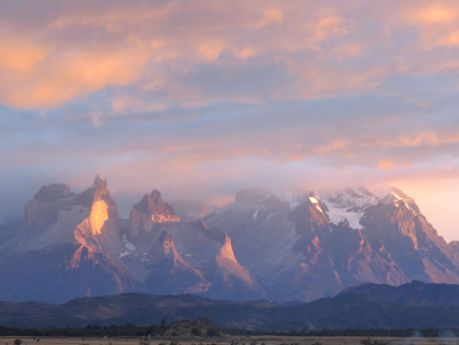PATAGONIA: Part Three – Torres Del Paine, One Of The World’s Most Beautiful Natural Wonders
Google Patagonia, Chile and the iconic picture that pops up is likely of The Masif. Photos of the 10,000 foot high giant rarely do it justice, especially when you’re staring at its snow-bald cap under a startling blue sky streaked with puffy white clouds. Few get to see The Masif preening in all its glory. Mostly the base is visible under a heavy blanket of fog or grey rain. Once again, the weather gods were kind to our intrepid group.
We’d seen the Masif in the distance, but our six-hour bus ride from Punta Arenas (where we’d disembarked from our ship, the Stella Australis) brought us up close and personal. For the next few days, the rustic 95-room Hotel Rio Serrano, located near the entrance of Torres del Paine National Park, would be our home. Our

An early morning rainbow bursts from the mountain in Torres del Paine area, just outside of our hotel. photo by Russ Wagner
Smithsonian Journeys-arranged lodging backed up to a horse farm, green and gold grasses, glaciers glinting in the sunrise orange sky and a rainbow bursting from the cracks of steep craggy mountains. Our large picture windows are open, welcoming in the completely unexpected warmth. The lobby is a Gaucho-inspired space with long, comfy couches, soft serape-blankets for cuddling up in during cool nights of watching the mountains under dimming moonlight.
Eating new foods, spices and cocktails have been a delightful boost to our experiences. We enjoy calafata, a berry used in just about everything. Ate pippen fish. Carefully sprinkled merken, a Latin American peppery seasoning, on my vegetables and proteins. Up to now, the coffee we’ve drunk has been strong and flavorful, just as Russ and I prefer. This is the first hotel that the coffee seems to be much weaker.
Hotel Rio Serrano’s manager gave us an unforgettable pre-dinner experience that began with munching on Sopapilla squares topped with tomato bruchetta while delighting in pisco sours. Then we went outside for a real South American lamb barbecue. The stone-enclosed fire pit had been attended to for hours that afternoon. The lamb was stretched on large steel skewers across the embers. The cook sliced off pieces for us. I love lamb, even if I rarely have it, but this was undoubtedly the best I’ve had. The crispy outside and juicy slices fresh from the barbeque were outstanding. I ate more than intended, so by the time we went in for the full buffet awaiting us, I didn’t have much room in my stomach left.
We began our first day’s trek into Torres del Paine, one of the two main reasons Russ arranged for this trip, with a planned hike into the 700-sq mile UNESCO World Biosphere Reserve. Our sightseeing agenda included the southern icefield of Lago Nordenskjold, Salto Grande’s roaring waterfall, Mirador Los Cuernos and Lago Grey. We walked across a windswept moraine in front of Gray Glacier, looming large even though still miles away.
The weather was stellar. Our Tour Director, Nick Tozer, and our local guide, Andrea, correctly assessed the weather conditions and switched around our schedule to maximize the spectacular view of The Masif and its adjacent mountains aptly named The Horns. We’d been prepared to face the day with rain pants and hurricane-force winds.
Lunch was at Grey Lake Restaurant, an open wood-and-glass refined and sophisticated dining venue. Russ adored a couscous that we have since searched the internet for. Alas, it isn’t available in the U.S. Just as we were leaving, the birdwatchers in our group became quite excited. A red-headed woodpecker and his mate, neither rarely seen up close, were pecking away at a tree just outside the door.
The next day included a bus tour and more hiking throughout Torres del Paine. We visited Amarga and Azul lagoons and the Cascade Rio Paine glacial waterfall. Our group’s birdwatchers were in their glory. There are 106 species of birds and 26 species of mammals recorded for this area.
We ate a boxed lunch that contained more food than any of us could possible devour. Whatever isn’t opened or touched was given to the forest service guards who watch over the lands. The day continued to amaze and defy whatever the guides could predict. Where seeing one to three guanacos (a wild llama) together is typical, we saw a herd pausing beside us on the road. Though their wool is softer than alpaca, which is used for ponchos, scarves, socks and other goods, the guanacos are so swift that they are rarely caught.
Andrea said our group emanates luck. In her 13 years of guiding, she has never seen so many instances of fortunate sightings, from the herd of guanacos to seeing more than a dozen condors soaring and dipping their wide black wings above us. We also were able to see the uncapped tips of the Horns, which many never get to see unshrouded by mist. There wasn’t one of our group who wasn’t humbled by the majesty of the surroundings and the stellar weather that enabled us to witness so much of the beauty.
Tomorrow will be a long coach ride back to Punta Arenas, where we board yet another flight to Puerto Montt.
Part One: Buenos Aires
Part Two: Ushuaia and Cruising on the Stella Australis
Next: Puerto Montt and Puerto Varas
Karen Kuzsel is a writer-editor based in the Orlando area who specializes in the hospitality, entertainment, meetings & events industries. She is a Contributing Editor-Writer for Prevue Magazine and is an active member of ISES and MPI and is now serving on the 2015 – 2016 MPI Global advisory Board for The Meeting Professional Magazine. Karen writes about food & wine, spas, destinations, venues, meetings & events. A career journalist, she has owned magazines, written for newspapers, trade publications, radio and TV. As her alter-ego, Natasha, The Psychic Lady, she is a featured entertainer for corporate and social events. karenkuzsel@earthlink.net; www.ThePsychicLady.com; @karenkuzsel; @thepsychiclady.







Leave a Reply
Want to join the discussion?Feel free to contribute!